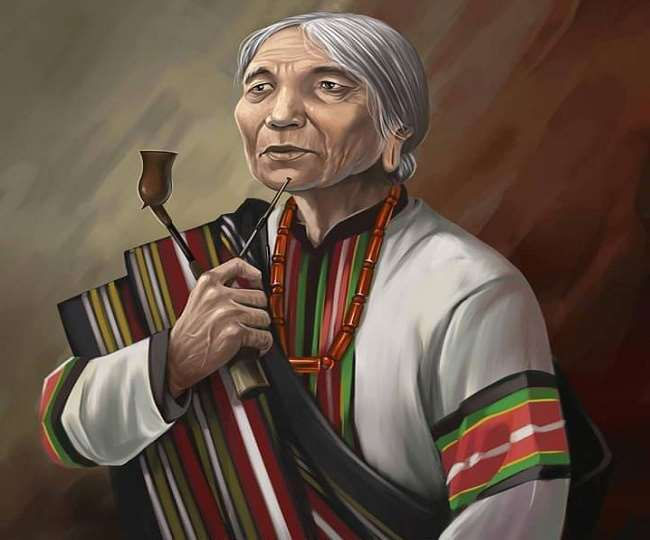Bharatiya Veerangana: Queen Ropuiliani
- Vedanti Vaidya
- May 7, 2024
- 4 min read
Updated: May 12, 2024

One may wonder, due to her name, how this warrior queen is a part of Indian history. Well, let us explore the diverse tapestry of Indian land, particularly the northeast, to Mizoram, formerly known as Lushai Hills. Until 1952, Mizoram was known as Lushai Hills, bearing the imprint of British colonization which renamed it Mizoram.
Queen Ropuiliani was born in 1828, the daughter of Raja Lal Samunga, chief of North Mizoram. She had 3 brothers and 2 sisters. Her father ruled the region from 1796 to 1842, upholding cultural heritage within the family and society. Her marriage to the chief of South Mizoram, Raja Vandula, linked her to the southern Lushai Hills, where cultural identity was also maintained. The responsibility of North Mizoram passed to her brother Saikuan. However, as she embarked on her personal journey, the British entered her life like a storm.
After the Battle of Plassey in 1757, the British gained control over Bengal and expanded their influence to encroach upon the nearby Lushai Hills. Following the Treaty of Yandaboo in 1826, parts of Assam merged with British-controlled areas, solidifying their grip. They owned tea gardens in Assam, becoming neighbours with the Queen.
Gradually, they began to influence and alter the traditions and customs of the Janajaati-s, even resorting to religious conversions. During her brother's reign, negotiations were made with the British, but in her village, the British demanded the opening of a road on the hill for troop movement. King Vandula fearlessly refused. Consequently, King Vandula became an adversary of the British Major C.S. Marray. Despite repeated attempts to entice the king with offers, he stood firm, rejecting their demands. In 1889, when the king passed away, the princess of North Mizoram became the queen of South Mizoram.
Queen Ropuiliani took up the mantle of leadership after her husband's demise. The British exploited the forest’s natural resources and imposed their rule on the Janajaati-s. However, Queen Ropuiliani's resistance incited a revolt against their oppressive regime. She vehemently opposed the British and their growing influence, rallying her people against exploitation. Her call for armed resistance resonated with the populace. Tensions escalated, resulting in clashes between the British and the Mizos, with casualties on both sides. Despite the odds, Queen Ropuiliani remained steadfast, refusing to cede Mizoram's land to the British. She declared, "The relationship of giving or providing favours to the British by the public does not arise; because we have never worked for anyone nor have, we ever been anyone's servants; because we ourselves are the owners of our lands."
On August 8, 1893, under the orders of Captains J. Shakespeare and Yulethsen, 80 soldiers launched a violent attack on Denglung, the queen's stronghold. In a fierce battle, the queen and her army valiantly fought against modern weaponry. Despite a proposed truce, she defiantly declared, "Mizoram's land is my mother, and no one trades her own mother." However, in the end, the queen and her son Lal Thawma were captured and imprisoned in Chittagoan. There, the British subjected her to severe torture, leading to her demise on January 3, 1895. Her son performed her last rites according to Mizo customs in their homeland. The Assam government established her monument in her memory in 2022.
Even though her physical presence faded, Queen Ropuiliani became immortalized in Indian history as a symbol of inspiration.

Reflections…
When observing communities in hills and forests compared to those on plains, often termed developed, communities in hills and forests are considered underdeveloped. We think that we have the responsibility to teach them the so-called path of development. But, while reading the historical story of the queen of Mizoram, we should contemplate some points:
1. The story of Mizoram's queen also prompts us to contemplate gender equality. The tradition of women taking charge after their husband's demise is common among Janajaati-s. Isn't this tradition a great example of equality?
2. The lifestyle of Janajaati-s has never harmed forest resources. Shouldn't we revisit our true historical roots and apply their practices to achieve sustainable development?
3. The struggles of Janajaati-s, like Queen Ropuiliani's, remind us of their resilience and the duty to uphold their rights. These stories challenge us to delve deeper into our true history and learn from it.
4. Even today, Indian women's strength lies not only in their abilities but also in their firm stance on their beliefs, in providing excellent leadership despite facing defeat, in enlightening society, and in being mentally strong along with physical strength. This independent spirit of women has been present in India for many years. But is it truly necessary for Indian women to completely change themselves according to modern global standards? This is a question worth considering.
5. Will the stories of several revolutionaries, sung consistently, continue to awaken our sense of duty towards sacred land with their sacrifices?
Complex Realities:
The current state language of Mizoram is Mizo and English. According to the 2011 census, 87.16% of the total population are Christians. Now, when so many Christians have come to Mizoram, it raises significant questions: from where and by what means did they come, and how did their numbers increase so significantly? These are numerous questions that need to be addressed. It means that some research will be needed to find their answers and in doing so, the true history of India will also emerge.
For this, a humble plea...
When news about Mizoram emerges, pause your scrolling, and read it. Stay informed about your own country, preventing outsiders from distorting your family's story.

||Jai Hind||




Comments